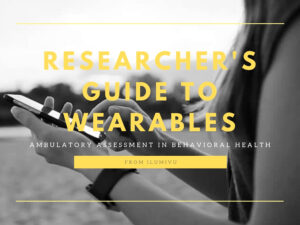
Just-in-time adaptive interventions (JITAIs) [1] are strategies that are designed to provide support at the most opportune time and are attuned to the needs of an individual. These approaches are adaptive in nature so that they can deal with dynamic real-world internal and external environments.
JITAIs are often used to promote healthy changes in behavior [2], such as reducing smoking and alcohol use, improving eating habits, and becoming more physically active. Because destructive behaviors can rapidly develop, JITAIs are designed to be event-based. In other words, rather than intervening at specific times [3] each day, JITAIs ideally intervene at opportunistic times, depending on contextual information about the user’s state or location.
Examples of JITAIs
JITAIs are taking off in the behavioral health space, with some specific programs already being pilot-tested. One program, called SitCoach [4], was designed to help people who work in officers to become more active. A smartphone app measures user’s computer time by monitoring keyboard and mouse activity. If 30 minutes of uninterrupted screen time occurs, the app delivers a compelling message to encourage the user to get up and walk. To enhance adherence, the app refrains from delivering multiple messages within a 2 hour period, even if the user exceeds the threshold for computer activity.
Another example of JITAI is called FOCUS [5], which is a smartphone intervention for managing illness in those with schizophrenia. The app signals patients to evaluate their status in 5 target domains 3 times each day. These domains include: medication adherence, social functioning, sleep, mood regulation, and hallucination coping.
Signals occur at times that patients are most vulnerable, namely when there is evidence that the patient is fatigued or undergoing an interpersonal conflict, as these scenarios put the patient at risk of relapse or exacerbated illness. If the patient chooses to engage, FOCUS assesses the patient in the domain areas. If the user is having difficulties, FOCUS provides relevant self-management strategies, whereas if the user is not having difficulties, FOCUS offers positive reinforcement and encouragement.
ACHESS [6] is another JITAI that aims to help people recover from alcohol use disorders. It employs global positioning system (GPS) technology to identify when an individual is nearing high-risk locations that the individual has identified as places where he or she has previously consumed or obtained alcohol. Upon approaching these locations, ACHESS sends a message to the user to ask if the person wants to be there. ACHESS also provides around-the-clock smartphone access to support services, addiction-related web content, and computerized cognitive behavioral therapy (CBT).
How to Effectively Study a JITAI
For JITAIs to be effective, they must incorporate expertise from different disciplines. For instance, clinical input is critical for improving health, while engineering input is vital for developing high-performing technology. Behavioral scientists are important for determining how to motivate healthy behaviors, while human-computer interaction specialists are valuable for optimizing technologies so that they are relevant and useful. No quantitate intervention is complete without statistics and the mobile nature of these technologies require computer scientists.
Thus to develop effective JITAIs and to test their impact, it is critical to have software that is conducive to interdisciplinary communication and data collection. The implementation and study of JITAIs not only requires high performing mobile technology like smartphones with sensors and integrated wearable devices but also software that properly processes and analyzes all the incoming information and then deploys optimal interventions.

Software supporting JITAIs must also:
- Allow for rapid iteration. The study of JITAIs is relatively new, it is necessary to be able to iterate freely, the be able to build-test-refine as much as necessary to create the best version possible.
- Allow for customized interfaces. While each JITAI is targeted to a specific demographic, there will be significant individual variations in users and in their behaviors. Customized interfaces [7] will improve the chances that the JITAI works for more of the targeted population.
- Allow for decision making rules. The app needs to know when to deliver an intervention message and which message to choose. These decision can be based on a variety of data including, self-report, phone sensor data and physiological data (from integrated wearable devices).

Takeaway
JITAIs offer a promising new way to promote healthy behaviors. Their success depends on the coordination of expertise across several domains and eventually the deployment of those coordinated efforts through high quality technology and specialized software.
References
[1] https://www.ncbi.nlm.nih.gov/pubmed/26651462
[2] https://www.computer.org/csdl/magazine/pc/2014/03/mpc2014030013/13rRUxDItev
[3] https://www.jstor.org/stable/3560239?seq=1#page_scan_tab_contents
[4] https://www.semanticscholar.org/paper/Toward-a-persuasive-mobile-application-to-reduce-Dantzig-Geleijnse/23f0f72692b801e1b435d6acae8fc649ad4e7ce3
[5] https://www.ncbi.nlm.nih.gov/pmc/articles/PMC4193714/
[6] https://www.ncbi.nlm.nih.gov/pmc/articles/PMC4016167/
[7] https://www.ncbi.nlm.nih.gov/pubmed/2713940
